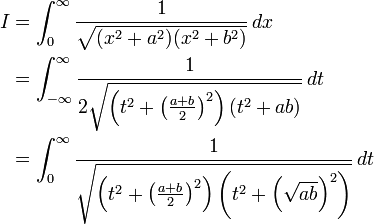Landen's transformation
Landen's transformation is a mapping of the parameters of an elliptic integral, useful for the efficient numerical evaluation of elliptic functions. It was originally due to John Landen and independently rediscovered by Carl Friedrich Gauss.[1]
Statement
The incomplete elliptic integral of the first kind F is
where  is the modular angle. Landen's transformation states that if
is the modular angle. Landen's transformation states that if  ,
,  ,
,  ,
,  are such that
are such that  and
and  , then[2]
, then[2]
Landen's transformation can similarly be expressed in terms of the elliptic modulus  and its complement
and its complement  .
.
Proof of a special case
Consider an example when the transformation does not change the value of the integral. Let
and  and
and  are replaced by their arithmetic and geometric means respectively, that is
are replaced by their arithmetic and geometric means respectively, that is
Therefore
From equation (aa) we conclude
and  .
.
The same equation can be proved by integration by substitution. It is convenient to first cast the integral in an algebraic form by a substitution of  ,
,  giving
giving
A further substitution of  gives the desired result
gives the desired result
This latter step is facilitated by writing the radical as
and the infinitesimal as
so that the factor of  is recognized and cancelled between the two factors.
is recognized and cancelled between the two factors.
Arithmetic-geometric mean and Legendre's first integral
If the transformation is iterated a number of times, then the parameters  and
and  converge very rapidly to a common value, even if they are initially of different orders of magnitude. The limiting value is called the arithmetic-geometric mean of
converge very rapidly to a common value, even if they are initially of different orders of magnitude. The limiting value is called the arithmetic-geometric mean of  and
and  ,
,  . In the limit, the integrand becomes a constant, so that integration is trivial
. In the limit, the integrand becomes a constant, so that integration is trivial
The integral may also be recognized as a multiple of Legendre's complete elliptic integral of the first kind. Putting 
Hence, for any  , the arithmetic-geometric mean and the complete elliptic integral of the first kind are related by
, the arithmetic-geometric mean and the complete elliptic integral of the first kind are related by
By performing an inverse transformation (reverse arithmetic-geometric mean iteration), that is
the relationship may be written as
which may be solved for the AGM of a pair of arbitrary arguments;
- The definition adopted here for
 differs from that used in the arithmetic-geometric mean article, such that
differs from that used in the arithmetic-geometric mean article, such that  here is
here is  in that article.
in that article.
References
- ↑ Gauss, C. F.; Nachlass (1876). "Arithmetisch geometrisches Mittel, Werke, Bd. 3". Königlichen Gesell. Wiss., Göttingen: 361–403.
- ↑ Abramowitz, Milton; Stegun, Irene A., eds. (December 1972) [1964]. Handbook of Mathematical Functions with Formulas, Graphs, and Mathematical Tables. Applied Mathematics Series 55 (10 ed.). New York, USA: United States Department of Commerce, National Bureau of Standards; Dover Publications. ISBN 978-0-486-61272-0. LCCN 64-60036. MR 0167642.
- Louis V. King On The Direct Numerical Calculation Of Elliptic Functions And Integrals (Cambridge University Press, 1924)



















